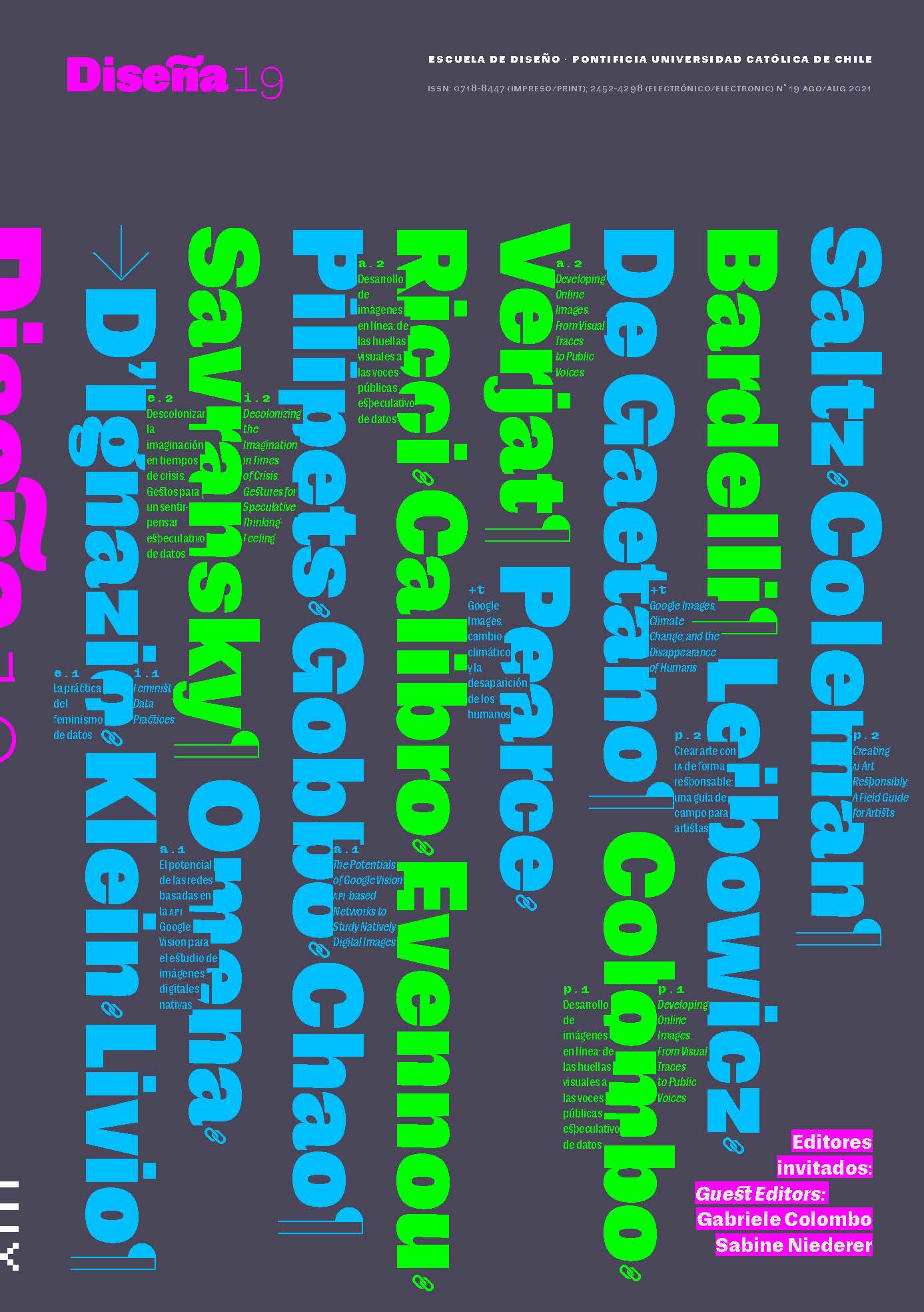Diseña 19 | Visual Methods for Online Images: Collection, Circulation, and Machine Co-Creation
Main Article Content
Abstract
In an image-saturated society, methods for visual analysis gain urgency. This special issue explores visual ways to study online images, focusing on their collection and circulation. The proposition we make is to stay as close to the material as possible. How to approach the visual with the visual? What type of images may one design to make sense of, reshape, and reanimate online image collections? How may arrangements of online images promote various analytical procedures, participatory actions, and design interventions? Furthermore, we focus on the role that algorithmic tools, including machine vision, can play in such research efforts while being sensitive to their flaws and shortcomings. Which kinds of collaborations between humans and machines can we envision to better grasp and critically interrogate the dynamics of today’s digital visual culture? The different practices and formats discussed in this special issue (including data feminism, visual scores, machine vision, image networks, field guides) offer a range of approaches that seek to understand, reanimate, and change perspectives on our digital visual culture.
Downloads
Article Details

This work is licensed under a Creative Commons Attribution-ShareAlike 4.0 International license.
COPYRIGHT NOTICE
All contents of this electronic edition are distributed under the Creative Commons license of "Attribution-ShareAlike 4.0 Internacional" (CC-BY-SA). Any total or partial reproduction of the material must mention its origin.
The rights of the published images belong to their authors, who grant to Diseña the license for its use. The management of the permits and the authorization of the publication of the images (or of any material) that contains copyright and its consequent rights of reproduction in this publication is the sole responsibility of the authors of the articles.
References
Aiello, G., & Parry, K. (2019). Visual Communication: Understanding Images in Media Culture. SAGE.
Bucher, T., & Helmond, A. (2018). The Affordances of Social Media Platforms. In J. Burgess, A. Marwick, & T. Poell (Eds.), The SAGE Handbook of Social Media (pp. 233–253). SAGE. https://doi.org/10.4135/9781473984066
Buolamwini, J., & Gebru, T. (2018). Gender Shades: Intersectional Accuracy Disparities in Commercial Gender Classification. Proceedings of Machine Learning Research, 81, 1–15.
Burkell, J., & Gosse, C. (2019). Nothing New Here: Emphasizing the Social and Cultural Context of Deepfakes. First Monday, 24(12). https://doi.org/10.5210/fm.v24i12.10287
Colombo, G. (2019). Studying Digital Images in Groups: The Folder of Images. In L. Rampino & I. Mariani (Eds.), Advancements in Design Research: 11 PhD Theses on Design as We Do in Polimi (pp. 185–195). Franco Angeli Open Access.
Crawford, K., & Paglen, T. (2019). Excavating AI: The Politics of Images in Machine Learning Training Sets. Excavating AI. https://excavating.ai
D’Ignazio, C., & Klein, L. F. (2020). Data Feminism. MIT Press.
Geboers, M. A., Stolero, N., Scuttari, A., Vliet, L. V., & Ridley, A. (2020). Why Buttons Matter: Repurposing Facebook’s Reactions for Analysis of the Social Visual. International Journal of Communication, 14(0), 22.
Geboers, M. A., & Van De Wiele, C. T. (2020). Machine Vision and Social Media Images: Why Hashtags Matter. Social Media + Society, 6(2), 2056305120928485. https://doi.org/10.1177/2056305120928485
Highfield, T., & Leaver, T. (2016). Instagrammatics and Digital Methods: Studying Visual Social Media, from Selfies and Gifs to Memes and Emoji. Communication Research and Practice, 2(1), 47–62. https://doi.org/10.1080/22041451.2016.1155332
Lister, M. (Ed.). (2013). The Photographic Image in Digital Culture. Routledge.
Niederer, S. (2018). Networked Images: Visual Methodologies for the Digital Age. Amsterdam University of Applied Sciences. https://research.hva.nl/en/publications/networked-images-visual-methodologies-for-the-digital-age
Niederer, S., & Colombo, G. (2021). The Earnest Platform: US Presidential Candidates, COVID-19, and Social Issues on Instagram. In R. Rogers (Ed.), Mainstreaming the Fringe: How Misinformation Propagates on Social Media. Amsterdam University Press.
Paglen, T. (2016, December 8). Invisible Images (Your Pictures Are Looking at You). The New Inquiry. https://thenewinquiry.com/invisible-images-your-pictures-are-looking-at-you/
Pearce, W., Özkula, S. M., Greene, A. K., Teeling, L., Bansard, J. S., Omena, J. J., & Rabello, E. T. (2020). Visual Cross-platform Analysis: Digital Methods to Research Social Media Images. Information, Communication & Society, 23(2), 161–180. https://doi.org/10.1080/1369118X.2018.1486871
Rose, G. (2014). On the Relation between ‘Visual Research Methods’ and Contemporary Visual Culture. The Sociological Review, 62(1), 24–46. https://doi.org/10.1111/1467-954X.12109
Sinders, C. (2020). Feminist Data Set. University of Denver. https://carolinesinders.com/wp-content/uploads/2020/05/Feminist-Data-Set-Final-Draft-2020-0526.pdf
Steyerl, H. (2013, November). Too Much World: Is the Internet Dead? E-Flux Journal, 49. https://www.e-flux.com/journal/49/60004/too-much-world-is-the-internet-dead/
Sze. (2018). Sarah Sze: Infinite Generation [Interview]. (L. Neri, Interviewer). Gagosian Quarterly, (Winter). https://gagosian.com/quarterly/2019/10/08/interview-sarah-sze-infinite-generation/
Tang, L., Fujimoto, K., Amith, M., Cunningham, R., Costantini, R. A., York, F., Xiong, G., Boom, J. A., & Tao, C. (2021). “Down the Rabbit Hole” of Vaccine Misinformation on YouTube: Network Exposure Study. Journal of Medical Internet Research, 23(1), e23262. https://doi.org/10.2196/23262
Tuters, M. (2020). Fake News and the Dutch YouTube Political Debate Space. In R. Rogers & S. Niederer (Eds.), The Politics of Social Media Manipulation (pp. 217–238). Amsterdam University Press. https://doi.org/10.2307/j.ctv1b0fvs5.9

